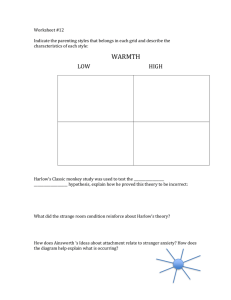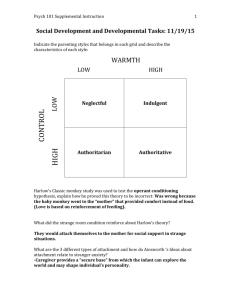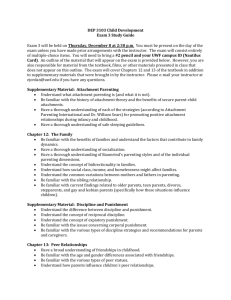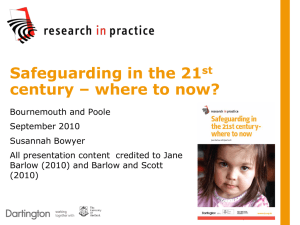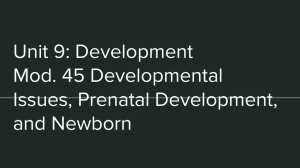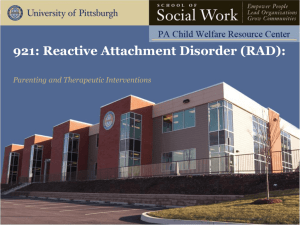A Whole-Brain Approach to Parenting - Dr. Naijean Bernard
advertisement
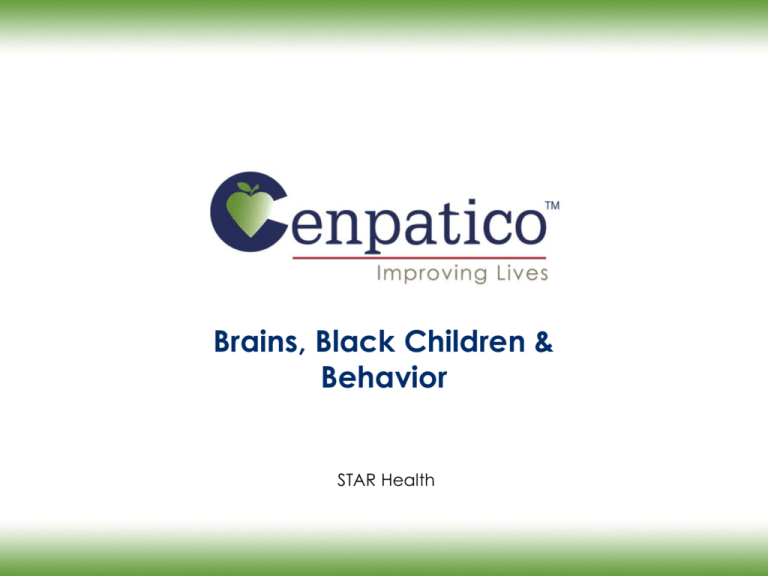
Brains, Black Children & Behavior STAR Health Objectives Understand basic brain functioning Learn more about the differences between the Upstairs and Downstairs brain Looking beyond “time out” - alternatives to physical punishment Explore the role of reflective parenting to repair insecure attachment Hot issues Tantrums Parents yelling at children Promiscuity Have fun through relaxation and group skits! 2 Brain Organ of thought and feeling; the controlling center of the nervous system in vertebrates, connected to the spinal cord and enclosed in the cranium (Webster) Mind A process that regulates the flow of energy and information (Daniel Siegel, M.D.) 3 Brain Functioning 101 4 Brain Functioning 101 Four Lobes Parietal Lobe Occipital Lobe Frontal Lobe Temporal Lobe Brainstem Basic functions such as Fight or Flight, carries out basic processes 5 Brain Functioning 101 Cortex • Six layer thick folds made up of grey and white matter allows us to make sense of the outside world, for example relating sights and sounds • On the exterior of the brain, looks like folds or wrinkles Corpus Callosum • The two hemispheres are connected by bundled fibers, allows hemispheres to process information 6 The Pre-Frontal Cortex • Responsible for integrating all other parts of the brain • Gives us ability to be emotionally balanced, selfaware • Responsive vs. reactive • Intentional with our bodies • Empathic • Intuitive 7 Amygdala and Hippocampus Amygdala o Gateway to our fears o Controls Flight, fight or freeze responses o Buried near the tip of the temporal lobe o Name comes from its shape, Latin for Almond Hippocampus o Responsible for encoding and organizing memories. o Classifies and categorizes them so they may be used at a later time 8 Hemispheres of the Brain Right Cares about the big picture, meaning and emotions Left Loves and desires order o Logical o Emotional o Linear o Non-verbal o Literal o Experiential o Linguistic 9 Upstairs vs. Downstairs Brain http://www.kidsinthehouse.com/elementary/communic ation/talking-with-five-to-seven-year-olds/using-theupstairs-brain-to-control#.VEavFiAU-gw.email 10 Upper and Lower Brain Upper brain o Has the ability to process logic and cause and effect o Uses right and left side to develop personal insight o Center for empathy and morality Lower brain o Instinctual o Fight, flight or freeze reactions o Operates more primal responses o Driven by strong emotions like fear and anger 11 Reflecting on Physical Punishment Donald, a 13 year old boy, was leaving school for the day when his father was waiting near the parking lot. School officials had called Donald’s father earlier that day to report that he was being disruptive in class. The father asked his son what happened. After Donald confirmed the school’s report on his behavior, the father unstrapped his belt and whipped his son in front of more than 20 students. Donald’s father had a reputation amongst his friends as a parent “who took no mess.” 12 Sounds familiar? 13 Alternatives to Physical Punishment http://www.kidsinthehouse.com/allparents/parenting/consequences-and-rewards/howcan-i-discipline-my-children-more-effectively http://www.kidsinthehouse.com/elementary/behaviorand-discipline/time-outs/do-time-outs-really-work 14 Attachment and the Brain • Ages 0-3 most rapid period of brain growth • Experiences shape how the brain grows (positive/negative) • Child feels safe/cared for o Brain uses its energy to develop pathways crucial for higherlevel thinking • Secure attachment allows a child to have more varied experiences and therefore build more neural connections 15 Attachment and the Brain Secure Attachment • Our children need to be: o o o o Seen Safe Soothed Secure o Can work with teens as well! 16 Mirror Neurons 17 Attachment and the Brain Insecurely Attached o Avoidant o Disconnected from others o Ambivalent/ anxious ….. o Sense of confusion regarding relationships o Disorganized o Fearful of attachment figure 18 The Role of a Coherent Narrative • Despite our childhood histories, we can all have a secure attachment with our children • The key is to have developed a coherent narrative of our own childhood. • If your child is showing signs of insecure attachment, do the work! o o o Looking at your own past first We are not doomed to replay past patterns We can create a new life for our children http://www.kidsinthehouse.com/allparents/parenting/parental-stress-and-anger/becomebetter-parent-understanding-yourown#.VEbKaBwkxLU.email 19 Reflective Parenting A process of reflecting a child's internal world; interpreting their actions with an understanding of the underlying thoughts, intentions, feeling in children's behavior. • Helps children provide a voice to a subjective experience, understand where things come from • Helps to repair attachment issues 20 Calming the Mind and Brain • Meditation is one way to calm the mind and brain • Helps to quiet the animal brain and step out of a fear response • With practice, one can call up memories of a meditative state and instantly calm oneself 21 Just Be Yourself! • 1st Stage (2 min) – Shaking o Let the body loose and start shaking. Move your arms, hips, shoulders and head. • 2nd Stage (2 min) – Gibberish o Tell the children to close their eyes and start speaking gibberish. Let them make any meaningless sounds they like. As they gibber they can let their hands and bodies move – swaying or jumping up and down. They can be as loud as they like. • 3rd Stage (2 min) – Laughing o Begin laughing for no reason at all. Just laughing! • 4th Stage (2 min) – Sitting silently o Sit silently and watch the breath and whatever is happening inside and outside. • 5th Stage (5 min) – Relaxing o Lie down and relax. http://www.madadalian.com/active-maditation-for-children.php 22 Teach your child about their Brain 23 Healthy Mind Parenting Tip: Connect and Redirect • Imagine that your child is in a “right brain” state, what would that look like? • What would happen if you tried to address them in a left brain mode? • What is the first thing we should do? http://www.kidsinthehouse.com/preschooler/beha vior-and-discipline/effective-discipline/how-handleupset-child#.VEaqtOZUKa4.email 24 Early Childhood – Stopping Tantrums http://www.kidsinthehouse.com/toddler/behavior-anddiscipline/tantrums/how-to-stop-tantrums-byunderstanding-the-brain#.VEardgf-7Kk.email 25 How to Stop Yelling at Our Children • Be kind to yourself, we all do it!! • Become aware of your triggers • Center yourself o o o Go outside, get fresh air See if anyone can watch your child Drink water • Apologize to your child • http://www.kidsinthehouse.com/allparents/parenting/parental-stress-and-anger/how-tostop-yelling-at-your-kids#.VEbLF9KX7FE.email 26 Promiscuity • • • • Past sexual abuse Peer influence Relationship Issues Trouble with impulse control • http://www.kidsinthehouse.com/teenager/sexuality/s exual-activity/four-reasons-your-teen-may-bepromiscuous#.VEbNrqJxpI8.email 27 Practice Makes Perfect! • Break up into groups of 10 • Look at your scenario/part of the brain that you were assigned • Come up with a memorable way to act this out for your fellow participants o o o Use props Do a relaxation exercise Do a cheer to say why your part of the brain is the best! 28 References • • • • http://children.meditation.org.au/whois.asp http://reflectiveparenting.org/ http://www.kidsinthehouse.com Austin, J.H. (2006). Zen Brain Reflections: Reviewing Recent Developments in Meditation and States of Consciousness MIT Press. • Siegel, D. The Mindful Brain: Reflections and Attunement in the Cultivation of Wellbeing. Norton Press. • Siegel, D. & Bryston, T.P. (2011). The Whole-Brain Child: 12 Revolutionary Strategies to Nurture Your Child’s Developing Mind, Survive Everyday Parenting Struggles, and Help Your Family Thrive. Delacorte Press 2011 • Siegel, D. (2010). Mindsight: The New Science of Personal Transformation. Random House. 29 Thank You! Cenpatico (866) 218-8263 30 Integrating the Parts – Scenario 1 Sarah, who is six years old, is walking with her father in Walmart. She sees the object of her hearts desire, a Furby toy she has wanted for a year. Sarah grabs the toy off the shelf and places it in her father’s cart. When the father removes it, Sarah screams “I WANT THAT FURBY NOW!” 31 Integrating the Parts – Scenario 2 Maria is a 12 year old girl who lives with her aunt. Her aunt tells you that Maria has recently become obsessed with death. She believes this may be due to the recent death of her biological mother from a drug overdose. Maria is now convinced she will die from some natural disaster and is thinking about it all the time . How can you help her? 32
